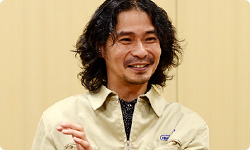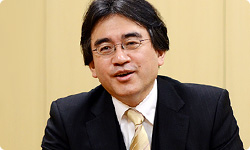3. Making the Bosses and Enemies
Now, Takizawa-san, I’d like to ask you about boss and enemy design.
Okay.
How do you begin making the bosses for a Legend of Zelda game?
In general, I start by receiving the enemy specs from Aonuma-san and considering the designs and functions there. Then, once the specs have come together somewhat, I go to Morita-san at SRD and have him make them move.

What I gave him was just the basic character arc.
So how the boss appears is the beginning, how the boss attacks is the development, how you beat it is the turn, and how that boss ends up is the conclusion.
Right. I just provided a framework and Morita-san and Takizawa-san fleshed it out while I waited and looked forward to seeing how it would turn out. But early on in development, I was groping around and drew some of my own sketches.
Huh? You did?
Yes. I was once a designer myself. (laughs) But one day, I showed Takizawa-san a sketch I had drawn and said, “I want you to make an enemy like this.” He cut me down, saying, “Aonuma-san, could you please stop drawing your own sketches?”
Why was that?
I thought, “But why?” and asked if my drawing was really that bad. He said it solidified the appearance, whereas he would rather be free to draw what he wants.
Takizawa-san wanted to start with a blank slate when he drew the bosses.
Sorry...but yeah.
But I really wanted him to follow that design! I was totally gutted. (laughs)
(laughs)
Oh, I really am sorry. I was young and insolent.
That’s OK. Because of such strong feelings, we were able to have a number of enemies with distinctive characteristics. In fact, Takizawa-san and Morita-san turned out a bunch of stuff far beyond what I had ever imagined.
Takizawa-san and Morita-san, how did you proceed with your work together?
I was practically a new guy and Morita-san was already a veteran, so I went back and forth to SRD as if I were training under him.
Back when we were in the former head office?7 7Former head office: Currently the Nintendo Kyoto Research Center in Higashiyama Ward, Kyoto City. In 2000, Nintendo moved its head office to Minami Ward, Kyoto City.
That’s right. SRD was in a different building than EAD. You could go in barefoot, which felt good, so I always went over.
Because it felt good? (laughs)
Yes. (laughs) I explained the enemies to Morita-san and he put the programming together right away. I’d look at it and say, “Could you make this a little more...” and about 15 minutes later, he’d show me the new movement. We did that over and over. I think that substantive back-and-forth time was a great learning experience. I learned how to do things as if I were playing catch.
Was that about your fourth year here?
It was my third year.
That’s quite a valuable experience to have in your third and fourth years. It was like you became an apprentice to Morita-san who has been in this business since the early days of the Famicom system.

That’s right.
You trained under your master, tossing the ball to him, to which he would respond by tossing it back in an amazing way. Even though he was your senior, you must have had some youthful insolence making you want to cut him down to size. (laughs)
Yes, that’s right. (laughs) I felt like I was privileged to learn from him, but I also had a strong desire not to let him beat me, so I wanted to cut him down to size.
We chatted about a lot of stuff completely unrelated to the game.
Oh, that’s right. He taught me about fishing. (laughs) If I asked about programming, though, I hadn’t studied that sort of thing, so I couldn’t understand it all. But when he showed me some amazing character movement, I couldn’t help but ask about it, saying, “How do you do that?”
Programmers are the kind of people who are pleased when they are asked “How do you do that?” (laughs)
Is that right? (laughs)
Yes! (laughs)
You don’t think, “If you don’t know anything about it, then don’t ask!” or something like that?
No, no. I believe you want to find some way of explaining it so people understand.
I know I do. Of course, it depends on what it’s about, though.
Yes, some things aren’t easy to explain.
An example from The Legend of Zelda: Ocarina of Time is the boss Volvagia, which looks like a dragon .
Yes. The boss in the Fire Temple.
Volvagia is a dragon, so it wriggles and undulates. I only gave Morita-san the dragon model parts, but he set it in motion immediately. It was mysterious how he could do that.
You were impressed - thinking,“I don’t get it, but wow!”
Yes. I couldn’t help but ask how he did it. He said it was the same as the programming for Star Fox 64. There’s this scene when another fighter aircraft is tailing Arwing and...
(jumping in) Oh, that? That’s right! It’s the same!
I should have known you’d pick up on it right away! (laughs)
Because he’s a programmer, too! (laughs)
But when I heard that, I didn’t quite get it. I just thought, “Wow, that’s cool...”
The way the fighter moves as it flies and Volvagia’s movements are exactly the same.
I could do it easily by switching the dragon for the fighter.
I was thinking “Amazing!” and “I see!” and had a great time every day marvelling over it all.